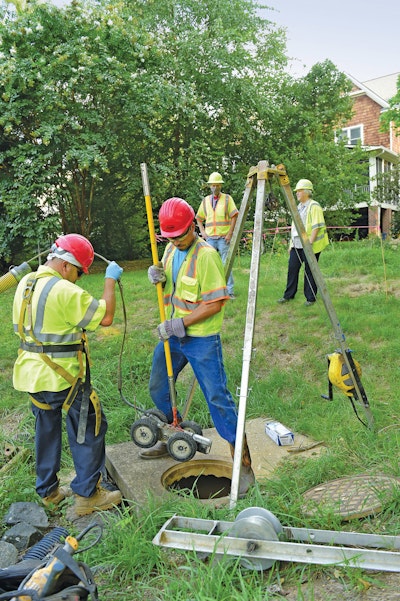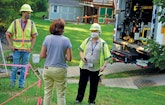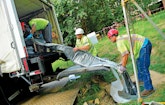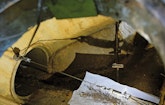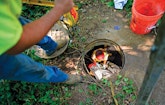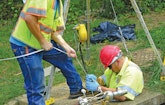
Julio Ramos and Michael Henderson of Pleasants Construction set up a slipsheet in preparation for lining a stormwater pipe.
Interested in Stormwater?
Get Stormwater articles, news and videos right in your inbox! Sign up now.
Stormwater + Get AlertsWhen tasked with creating a program for dealing with its aging stormwater collections system, the Fairfax County (Virginia) Stormwater Infrastructure Branch embarked on a journey of discovery. In the end, being unafraid to try untested approaches, using new trenchless technologies, and adopting a proactive approach to maintenance has set the county up to preserve its critical drainage assets for many generations.
Fairfax County is situated within the Chesapeake Bay watershed and is bordered on one side by the Potomac River, with rolling hills on its western boundaries. It is a diverse landscape that includes wetlands, native vegetation and groves of mature trees. Lush green areas are great attractions for residents.
Like most residential areas near major metropolitan centers, it has experienced its share of growth. Many of the county stormwater conveyance assets run through private property, and some are shared assets with the local Virginia Department of Transportation.
Valerie Tucker, P.E., chief of the Stormwater Infrastructure Branch within the Stormwater Management Division of the Department of Public Works and Environmental Services of Fairfax County, had to take all of this into account when she was tasked with developing a long-range maintenance program for the closed portion of the county’s stormwater conveyance system. The closed stormwater system includes approximately 1,375 miles of pipe and storm structures, with 200 miles of open channel and man-made improvements in what the agency defines as its open system. The closed system is comprised of 12- to 84-inch-diameter reinforced concrete pipe (average size is 15 inch) with a small amount of corrugated metal pipe that was installed in the 1950s and ’60s.
When the storm systems were built in the older areas of the county, there were no standards in place. “A lot of our problem areas are in these sections that were developed before we had stormwater management and drainage requirements, so systems can be undersized and not able to meet today’s standards,” Tucker relates.
In addition, a good number of the pipelines in the system are located between homes or are “shared pipes” with the VDOT. These multiple jurisdictions and responsibilities require Tucker and her team to collaborate and coordinate efforts to make sure repairs and rehabilitation are handled promptly and properly.
In situations where lines run in and out of the road right-of-way and there is an easement, the county requires development to include a full 10-foot easement for all its stormwater pipes. If a line is too close to the edge of the right-of-way, a sliver of easement outside of it will be dedicated to the county for maintenance. “We are all about maintenance, so with the help of the local Board of Supervisors that maintains contacts with the various agencies, as well as the residents, we coordinate our efforts to make things happen,” Tucker explains.
Building a database
Under its VPDES, or Municipal Separate Storm Sewer System permit, Fairfax County is required to inspect all its pipelines at least once every five years. One of the department’s engineering technicians walks all the pipes, opens the catch basin lids and performs a Level 1 condition assessment review. Using the Esri ArcGIS Collector app, the inspector goes through a checklist, takes photos and inputs the findings into the app along with the GIS mapping information.
If immediate maintenance work is needed, a work order will be issued. In the case of a severe issue, maintenance crews will be asked to come and do a follow-up assessment and, if necessary, escalate it to Michael Dreher, section chief, to determine next steps.
In 2008, the county began video-inspecting its system. During the first 10-year pass, it began building a database of deficient pipes. “As we were getting started, we didn’t know what we might find. We had some expectations and enlisted the help of a consultant to map out a little bit of a plan to address the issues we were finding, but it was particularly challenging,” Tucker relates.
Assessment analysis
Most of the maintenance programs, systems and defect coding standards that Tucker and her team could draw from were developed for sanitary collections systems, not stormwater. “We quickly found out that there are a lot of differences between the two, although many people seem to believe they’re similar.”
A prime example was the integration of VDOT-owned lines or shared pipes. Tucker and her team calculated that there were probably as many private and VDOT assets in place as there were county lines that they were responsible for. These were all connected and could impact each other’s performance.
Other major differences were in assessment analysis. Fairfax County could use its Granite Xp (CUES) Pipeline Assessment and Certification Program data collection software, but the defect codes, findings and elements specifically related to stormwater conveyance or drainage systems were not available. The team manipulated the existing coding standards as much as feasible, but it placed limits on the amount of data analysis that could be generated to provide an accurate picture of what should be addressed and how and when that should occur. It did, however, provide the team members with a solid triage base to help them rank their pipes on the first inspection pass. They also created their own quick score method.
One of the biggest surprises uncovered during their video inspection was the number of offset joints and joint failures and how these defects impacted the system. The issues were attributed to original construction practices; unlike sanitary pipes, which are pressure-tested before being put into service, storm drainage assets are simply laid, and years of annual storm cycles had taken their toll.
The right fix
With enough data in hand on which assets needed attention, Tucker began putting together a plan for rehabilitation. One of the major challenges she faced was with the bidding process established by the county.
“The system is set up so that you have to know what it is you want to use for a project before you can put it out for bid,” Tucker says. “We had no history to draw from because, like the inspection process, the data available was centered on sanitary systems.”
It was a little like putting the cart before the horse. But being unafraid to try new things, she relied upon the successes of the various forms of trenchless technology used in the rehabilitation of Fairfax County’s sanitary system and was hopeful they could be modified to fit the stormwater applications.
For the joint offsets and failures, Fairfax County first tried a test-and-seal process using pressure grouting from Avanti International. In comparison with wastewater systems, storm pipe sections are typically shorter. As a result, there are many more joints and potential for seepage and separation. Although grouting was effective, it was determined to be more cost-effective to reline entire segments in situations where every joint required remediation.
They also tried Snap-Tite sliplinings (ISCO Industries), which were performed in a few small dam embankments. The requirement of an open end for deployment limited the number of instances where this trenchless method could be cost-effective and logistically feasible.
CIPP lining using felt and resin configurations from various manufacturers had worked well in the county’s sanitary collections system, but it became burdensome for stormwater applications due to styrene emissions. Using this process required Fairfax County to pump all of the water existing in the line, as well as any water or steam in the pipe used for curing, to the closest sanitary line, as it could not be released into the host pipe’s stream.
Tucker then learned about UV-cured glass-reinforced pipe lining and ALPHALINER from Reline America. This form of lining emerged as the solution to many of the county’s needs. The fact that it would eliminate water removal requirements, styrene emissions and be performed with little disruption to the community made it the most attractive of all the technologies that had been implemented to date.
One of the county’s major goals in approaching any of its maintenance projects, whether for sanitary collections systems or stormwater conveyance, is that they limit disruption of the community and eliminate as much as possible any damage or loss to green spaces and landscaping.
In one subdivision, Polo Place, maturing trees were growing on top of buried stormwater pipes. It was imperative for the county to rehabilitate the line before the trees got too heavy and collapsed the pipe. The tree roots were growing into all of the joints and needed to be manually cut out from the 48-inch-diameter twin drainlines before they could be lined. Not only did the ALPHALINER UV GRP lining restore integrity to the lines, it created a barrier against further root intrusion and allowed the trees to remain on the property.
“Being able to try these different trenchless technologies has been a big benefit and essential for creating our long-term plan for the communities we serve, UV relining especially. The disruption is so limited that property and landscaping is left undisturbed. On some projects, residents leave for work in the morning and when they return, they would never have known we were there, and that’s really nice,” Tucker says.
Innovating and testing
Early on, Tucker had envisioned her department approaching things methodically, step-by-step, taking all the inventory and mapping it, performing the condition assessment and then moving onto repairs, but she was guided otherwise. Having a comprehensive maintenance, inspection and rehabilitation program was new for this division.
“I was led to start rehabilitating and relining pipe at the early onset of the program so that the benefits could be seen upfront,” Tucker says. “By doing this, we gained support from both citizens and the Board of Supervisors for us to continue.”
Fairfax County now has a great start to chart the course of its future generational stormwater system maintenance and rehabilitation program. “You can never have too much information,” Dreher shares. “Having tools available that are designed for the stormwater environment would be a tremendous help. Just like our sanitary systems, our challenge going forward will be not only to maintain, assess and rehabilitate, but also predict how much life is left in an asset based on the defects we see, how they are coded and the data analyzed.”
But until those tools arrive, Tucker and her department will continue to bravely try new technologies, ask questions and innovate to keep their program moving forward, consistently delivering results to this beautiful region of Virginia.
